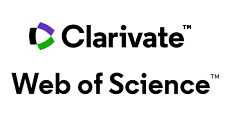Published
Determination of Distance Required to Ensure Stope and Footwall-drift Non-interaction Zone based on Geological Strength Index
Determinación de la distancia requerida para asegurar el rebaje y las galerías en muros de la zona de no interacción en minería subterránea con base en el Índice de Resistencia Geológica
DOI:
https://doi.org/10.15446/esrj.v23n1.71879Keywords:
Footwall drift, numerical analysis, underground stability (en)galería en muro, análisis numérico, estabilidad subterránea (es)
Downloads
En la mina de cobre de Bakibaba se utiliza el método de minería por perforación de barrenos largos para extraer el mineral. Los problemas de estabilidad han ocurrido generalmente en las galerías en muro debido a la interacción entre la galería y el rebaje. En este estudio se propone un método para la estimación de la distancia mínima necesaria para asegurar la zona de no interacción entre la galería en muro y el rebaje. Se utilizó como parámetro el método del elemento finito y varias distancias entre la galería en muro y el rebaje y los desplazamientos sobre las galerías. También se realizaron análisis con varios índices de resistencia geológica de abajo hacia arriba para determinar el efecto de la masa rocoa en la interacción entre la galería en muro y el rebaje.
References
Abdellaha, W., Mitria, H., & Thibodeau, D. (2011). Assessment of Mine Haulage Drift Safety Using Probabilistic Methods of Analysis. Procedia Engineering, 26, 2099–2111. DOI: https://doi.org/10.1016/j.proeng.2011.11.2412
Addenbrooke, T. I., & Potts, D. M. (2001). Twin tunnel interaction: surface and subsurface effects. International Journal of Geomechanics, 1(2), 249–271
Chakeri, H., Hasanpour, R., Hindistan, M. A., & Unver, B. (2011). Analysis of interaction between tunnels in soft ground by 3D numerical modeling. Bulletin of Engineering Geology and the Environment, 70, 439–448. DOI: http://dx.doi.org/10.1007/s10064-010-0333-8
Gercek, H. (2005). Interaction between Parallel Underground Openings. The 19th International Mining Congress and Fair of Turkey, IMCET
Ghaboussi, J. & Ranken R. E. (1977). Interaction between Two Parallel Tunnels. International Journal for Numerical and Analytical Methods in Geomechanics, 1(1), 75-103. DOI: https://doi.org/10.1002/nag.1610010107
Hoek, E., Carranza-Torres, C. & Corkum, B. (2002). Hoek-Brown Failure Criterion- 2002 Edition. Proceedings NARMAS-TAC Conference, Toronto, 1,267-273
Jing, L., & Hudson, J. A. (2002). Numerical methods in rock mechanics. International Journal of Rock Mechanics and Mining, 39, 409–427.
Kabwe, E., & Bowa, V. M. (2016). Determination of the Appropriate Geometry of Footwall Drifts Using Numerical Analysis Technique. Geotechnical and Geological Engineering, 34, 1955–1969. DOI: https://doi.org/10.1007/s10706-016-0076-9
Karakus, M., Ozsan, A., & Basarir, H. (2007). Finite element analysis for the twin metro tunnel constructed in Ankara Clay-Turkey. Bulletin of Engineering Geology and the Environment, 66, 71–79. DOI: http://dx.doi.org/10.1007/s10064-006-0056-z
Ozdogan, M. V, Yenice, H., Gonen, A., & Karakus, D. (2017). Optimal Support Spacing for Steel Sets: Omerler Underground Coal Mine in Western Turkey. International Journal of Geomechanics, 18(2), 05017003- 1-12. http://dx.doi.org/10.1061/(ASCE)GM.1943-5622.0001069
Purwanto, A., Shimada, H., Sasaoka, T., Wattimena, R. K., & Matsui, K. (2013). Influence of Stope Design on Stability of Hanging Wall Decline in Cibaliung Underground Gold Mine. International Journal of Geosciences, 4, 1-8. DOI: http://dx.doi.org/10.4236/ijg.2013.410A001
Sharma, K. G. (2009). Numerical analysis of underground structures. Indian Geotechnical Journal, 39(1), 1–63
Sheorey P. R. (1994). A theory for in situ stresses in isotropic and transversely isotropic rock. International Journal of Rock Mechanics and Mining Sciences, 31(1), 23-34. DOI: https://doi.org/10.1016/0148-9062(94)92312-4
Wang, B., & Li, S. (2008). A complex variable solution for stress and displacement field around a lined circular tunnel at great depth. International Journal for Numerical and Analytical Methods in Geomechanics, 33, 939-951. DOI: https://doi.org/10.1002/nag.749
Wang, H. N., Zenga, G. S., Utilic, S., Jiangd, M. J., & Wua, L. (2017). Analytical solutions of stresses and displacements for deeply buried twin tunnels in viscoelastic rock. International Journal of Rock Mechanics & Mining Sciences, 93, 13–29. DOI: https://doi.org/10.1016/j.ijrmms.2017.01.002
Wang, J., Milne, D., Wegner, L. & Reeves, M. (2007). Numerical Evaluation of the Effects of Stress and Excavation Surface Geometry on the Zone of Relaxation around Open Stope Hanging Walls. International Journal of Rock Mechanics & Mining Sciences, 44(2), 289-298. DOI: http://dx.doi.org/10.1016/j.ijrmms.2006.07.002
Yamaguchi, I., Yamazaki, I., & Kiritani, K. (1998). Study of ground-tunnel interactions of four shield tunnels driven in close proximity, in relation to design and constructions of parallel shield tunnels. Tunnelling and Underground Space Technology, 13(3):289–304. DOI: https://doi.org/10.1016/S0886-7798(98)00063-7
How to Cite
APA
ACM
ACS
ABNT
Chicago
Harvard
IEEE
MLA
Turabian
Vancouver
Download Citation
CrossRef Cited-by
1. Omar Ghazdali, Jalal Moustadraf, Tarik Tagma, Bahija Alabjah, Fouad Amraoui. (2021). Study and evaluation of the stability of underground mining method used in shallow-dip vein deposits hosted in poor quality rock. Mining of Mineral Deposits, 15(3), p.31. https://doi.org/10.33271/mining15.03.031.
2. Xuan Wang, Xiang Pu, Bo Wang, Qiong Zhang, Jianing Wang. (2021). Key technologies of nuclear accident consequence assessment system based on OpenGIS. Arabian Journal of Geosciences, 14(13) https://doi.org/10.1007/s12517-021-07518-0.
3. Carlos Saldaña-Paredes, Humberto Pehovaz-Alvarez, Carlos Raymundo. (2021). Advances in Manufacturing, Production Management and Process Control. Lecture Notes in Networks and Systems. 274, p.176. https://doi.org/10.1007/978-3-030-80462-6_22.
Dimensions
PlumX
Article abstract page views
Downloads
License
Copyright (c) 2019 Earth Sciences Research Journal

This work is licensed under a Creative Commons Attribution 4.0 International License.
Earth Sciences Research Journal holds a Creative Commons Attribution license.
You are free to:
Share — copy and redistribute the material in any medium or format
Adapt — remix, transform, and build upon the material for any purpose, even commercially.
The licensor cannot revoke these freedoms as long as you follow the license terms.
The Earth Sciences Research Journal is the copyright holder for these license attributes.























